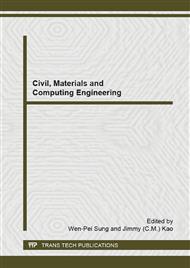[1]
Seul-Ki Lee , Ka-Ram Kim , Jung-Ho Yu, BIM and ontology-based approach for building costestimation, Automation in Construction, Volume 41, May 2014, Pages 96–105.
DOI: 10.1016/j.autcon.2013.10.020
Google Scholar
[2]
HuierXu. JingchunFeng, Shoude Li, Users-orientated evaluation of building information model in the Chinese construction industry, Automation in Construction, Volume 39, 1 April 2014, Pages 32–46.
DOI: 10.1016/j.autcon.2013.12.004
Google Scholar
[3]
Huang Wei-chin, A Study of Fire Safety Equipment Cost Analysis Based on LCCA Model, Graduate Institute of Architectural Design, China University of Technology, (2014).
Google Scholar
[4]
Davis, FD. 1986. A technology acceptance model for empirically testing new end-user information systems: Theory and results, Doctoral dissertation, Sloan School of Management, Massachusetts Institute of Technology.
Google Scholar
[5]
Davis, F.D. 1989. Perceived usefulness, perceived ease of use, and user acceptance of information technology, MIS Quarterly(13: 3), pp.319-339.
DOI: 10.2307/249008
Google Scholar
[6]
Venkatesh, V., Morris, M. G, Davis, G.B., and Davis, F.D. 2003. User acceptance of information technology: Toward a unified view, MIS Quarterly(27: 3), pp.425-478. 2.
DOI: 10.2307/30036540
Google Scholar
[7]
Robert Eadie, Mike Browne, Henry Odeyinka, Clare McKeown, Sean McNiff, BIM implementation throughout the UK construction project lifecycle: An analysis, Automation in Construction, Vol. 36, pp.145-151.
DOI: 10.1016/j.autcon.2013.09.001
Google Scholar
[8]
Szajna, B. Empirical evaluation of the revised technology acceptance model. Management Science, 42(1), 85-92.
DOI: 10.1287/mnsc.42.1.85
Google Scholar


